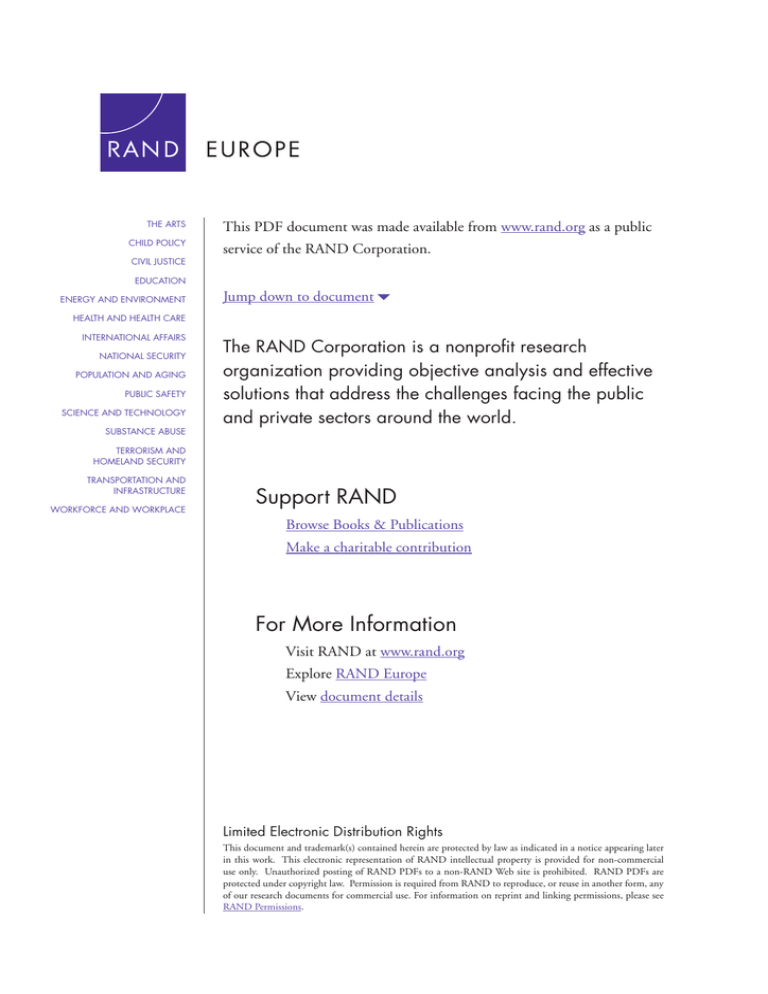
THE ARTS
CHILD POLICY
CIVIL JUSTICE
This PDF document was made available from www.rand.org as a public
service of the RAND Corporation.
EDUCATION
ENERGY AND ENVIRONMENT
Jump down to document6
HEALTH AND HEALTH CARE
INTERNATIONAL AFFAIRS
NATIONAL SECURITY
POPULATION AND AGING
PUBLIC SAFETY
SCIENCE AND TECHNOLOGY
SUBSTANCE ABUSE
The RAND Corporation is a nonprofit research
organization providing objective analysis and effective
solutions that address the challenges facing the public
and private sectors around the world.
TERRORISM AND
HOMELAND SECURITY
TRANSPORTATION AND
INFRASTRUCTURE
WORKFORCE AND WORKPLACE
Support RAND
Browse Books & Publications
Make a charitable contribution
For More Information
Visit RAND at www.rand.org
Explore RAND Europe
View document details
Limited Electronic Distribution Rights
This document and trademark(s) contained herein are protected by law as indicated in a notice appearing later
in this work. This electronic representation of RAND intellectual property is provided for non-commercial
use only. Unauthorized posting of RAND PDFs to a non-RAND Web site is prohibited. RAND PDFs are
protected under copyright law. Permission is required from RAND to reproduce, or reuse in another form, any
of our research documents for commercial use. For information on reprint and linking permissions, please see
RAND Permissions.
This product is part of the RAND Corporation documented briefing series. RAND
documented briefings are based on research briefed to a client, sponsor, or targeted audience and provide additional information on a specific topic. Although documented
briefings have been peer reviewed, they are not expected to be comprehensive and may
present preliminary findings.
Health and Medical
Research in the United
Kingdom
Observatory on Health Research
Systems
Sally Hargreaves
The research described in this report was prepared as part
of RAND Europe's Health Research System Observatory
Documented Briefing series, funded by the English Department
of Health.
The research described in this report was prepared as part of RAND Europe's Health
Research System Observatory Documented Briefing series, funded by the English
Department of Health.
The RAND Corporation is a nonprofit research organization providing objective analysis
and effective solutions that address the challenges facing the public and private sectors
around the world. RAND’s publications do not necessarily reflect the opinions of its
research clients and sponsors.
R® is a registered trademark.
© Copyright 2008 RAND Corporation
All rights reserved. No part of this book may be reproduced in any form by any electronic or
mechanical means (including photocopying, recording, or information storage and retrieval)
without permission in writing from RAND.
Published 2008 by the RAND Corporation
1776 Main Street, P.O. Box 2138, Santa Monica, CA 90407-2138
1200 South Hayes Street, Arlington, VA 22202-5050
4570 Fifth Avenue, Suite 600, Pittsburgh, PA 15213-2612
Westbrook Centre, Milton Road, Cambridge CB4 1YG, United Kingdom
RAND URL: http://www.rand.org
RAND Europe URL: http://www.rand.org/randeurope
To order RAND documents or to obtain additional information, contact
Distribution Services: Telephone: (310) 451-7002;
Fax: (310) 451-6915; Email: order@rand.org
Summary
Summary: Key Points
• Key funder of health R&D in the United Kingdom is industry
• R&D is an important part of the UK economy
• UK R&D system benefits from links with the National Health Service,
the largest health service delivery organisation in the world
• Government investment has been lower than in most EU countries
• Strong tradition of funding biomedical research
• Future challenges in emerging markets and workforce issues
The main funders of health research and development (R&D) in the United Kingdom are
industry, government, and research charities. Industry contributes the overwhelming
majority of funds to health research, and most of this work is undertaken commercially,
resulting in the high profile of health R&D in the UK economy. Universities and the
National Health Service (NHS) also play a part in the production of world-class research
in the United Kingdom.
Government investment has historically been lower than in most other European
countries. However, in 2004, the UK government published a ten-year plan for increased
investment in health R&D, and a new health research strategy was launched in 2006. This
strategy calls for the ring-fencing of funds for health R&D, and the facilitation of closer
alignment with industry, which should help in the prioritisation and coordination of
research.
Although the United Kingdom has a strong tradition of funding biomedical research, a
government-commissioned review has called for a shift from basic research towards
translational and applied research to make better use of the NHS, and to increase
economic and health benefits for all UK citizens.2 This initiative has already involved the
2
Basic research, also referred to as ‘fundamental’ or ‘blue skies’ research, asks questions about health and
disease without any primary driver for practical application. Translational research refers to the process of
vii
Health and Medical Research in the United Kingdom
RAND Europe
Medical Research Council in setting up university-based centres to work closely with
industry to bring new innovations into the marketplace.
The United Kingdom now faces numerous challenges in terms of expanding its R&D
programme and maintaining its high quality outputs. India and China are becoming more
attractive than the United Kingdom as investment locations, so the UK government needs
to find ways to attract and retain R&D companies. The current shortfall in suitably skilled
scientists and technicians in the United Kingdom makes this issue all the more pertinent.
taking the findings from basic or clinical research and using them to produce innovation in healthcare settings.
Applied research covers a wide range of research, primarily involving human volunteers. It is driven by the
desire to answer a specific health-related question, need or desire to improve services or care (Cooksey, 2006).
viii





